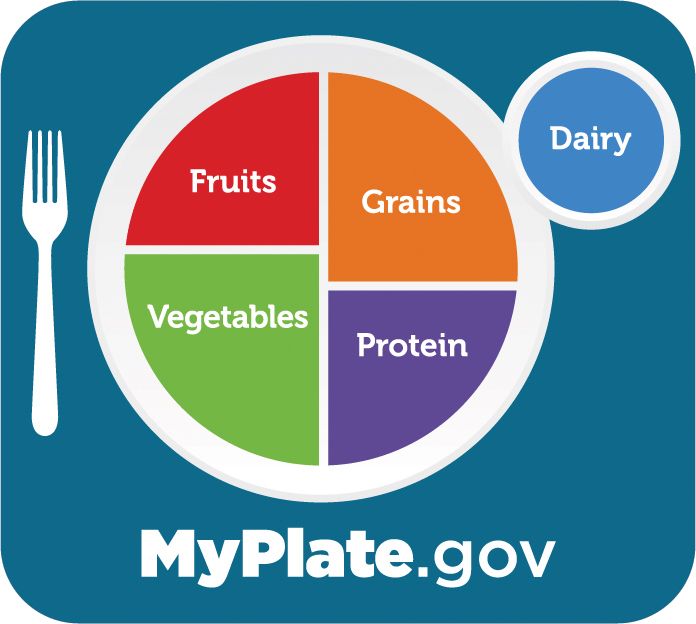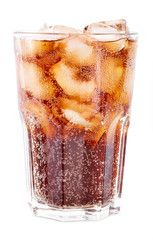Did you know that water makes up more than half your body weight? Every cell in your body needs water to function correctly. That’s why it’s important to stay hydrated. To do so, you need to replace the water you lose through breathing, sweating, and urinating. Even though all fluids provide hydration, water is a better choice. The information in this publication can help you learn why.

Credit: http://www.myplate.gov/
Why Water?
Water doesn’t have calories or sugar, unlike sugary drinks such as soda, fruit drinks, and sports drinks that can contain added sugars. The term “added sugars” means that sugar has been added to the beverages, usually to make them taste sweeter. Sugary drinks, also known as calorie-dense beverages, are high in calories and low in nutrients.
Consuming more than 10 percent of your daily calories from added sugar can contribute to excess calorie intake, which can lead to weight gain. Being overweight can cause serious health problems like heart disease and diabetes. Consuming a lot of sugar can also damage your teeth, increasing your risk of developing painful and costly cavities (CDC, 2022). Water is the ideal choice to meet your body’s fluid needs.

Credit: Adobe Stock
How Much Water to Drink?
Each individual’s needs will vary. Additionally, exercise, climate, health conditions, and other factors can contribute to needing more or less water (Harvard School of Public Health, n.d.). Recommended amounts per day are:
1–3 years: 4 cups
4–8 years: 5 cups
9–13 years: 7–8 cups
14–18 years: 8–11 cups
Women 19 and older: 9 cups
Men 19 and older: 13 cups
What’s in Your Drink?
Choosing water over sugary drinks can make a big difference to your overall health and well-being. Table 1 compares the amount of calories and sugar found in various drinks and water. It’s easy to see how “drinking your calories” can quickly add up.
Table 1. Amount of sugar and calories in various beverages.
Sugar, Sugar, Sugar
Added sugars can go by many different names, but they all provide extra calories and can have the same bad effects on your health. Other names for added sugars include the following:
- high fructose corn syrup
- rice, malt, or cane syrup
- cane sugar or cane juice
- raw, brown, powdered, or invert sugar
- glucose, sucrose, maltose, dextrose, or lactose
- honey or molasses
- fruit juice concentrate

Credit: Adobe Stock
Less than 10 percent of daily calories should come from added sugar. For someone on a 2,000 calorie per day diet, that would be 200 calories (or 50 grams of added sugar per day) (FDA, 2023). However, the average caloric intake of added sugar per day in the U.S. is 266 calories, with sugar-sweetened beverages being the number one source of added sugar in the average American’s diet (Dietary Guidelines for Americans, 2020). Use the nutrition information panel to find out how much sugar is in a single serving of different beverages and choose the one lowest in sugar!
Sugar is listed in grams on the nutrition facts label. Since one teaspoon contains 4 grams of sugar, the average 20-ounce bottle of soda with 65 grams of sugar contains 16 teaspoons of sugar (65/4)! That same bottle of soda also contains 260 calories, all from sugar.
The nutrition facts panel has a row for total sugars and another for added sugars. This lets you differentiate between how much sugar is naturally occurring in the beverage (e.g., fructose in 100% orange juice versus added sugar in an orange drink) and how much is added during processing (FDA, 2023).
100% Fruit Juice, Milk, and Diet Drinks
Although 100% fruit juice has no added sugars, it contains calories from natural sugars, and it lacks dietary fiber found in whole fruit. One hundred percent fruit juice can still be part of a healthful diet when consumed in small amounts (4–10 fluid ounces, depending on one’s calorie level) (Dietary Guidelines for Americans, 2020). Fruit drinks, on the other hand, contain added sugars and typically do not offer the same nutritional value as 100% juice products. If the title of the product includes “fruit drink,” “beverage,” or “punch,” then it is just a fruit-flavored drink that has added sugar. Check the ingredients list: if the first ingredient is not the fruit juice, then it is likely a fruit-flavored beverage with added sugar. Look at the top of the nutrition facts panel to see the percent juice it contains (Rellinger, 2013).
Like 100% fruit juice, milk contains natural sugar, and is a nutrient-rich beverage choice, especially if it is low-fat or fat-free. Many children prefer flavored milks, which can also play a part in meeting daily needs.
Even though diet drinks are low in calories, they have no nutritional value. Diet drinks are an alternative to sugary drinks, but water is still the best choice.
Making the Switch
Now is the time to start making the change to drinking primarily water if you aren’t already doing so. The following tips can help you stay hydrated, consume fewer calories, and drink less sugar from beverages:
- Start the day with a glass of water!
- Add water into an existing routine: during a meal, after brushing your teeth, upon arriving at work, etc.
- Always have a water bottle when you’re on the go and refill it throughout the day.
- Always choose water over sugary drinks. Add fresh fruit or vegetable slices such as lemon, pineapple, or cucumber to add a naturally sweet flavor.
- If you miss the bubbly part of soda, try seltzer or sparkling water instead.
- If you choose to continue to drink sugary drinks, do so in moderation and not on a daily basis.
- Dilute sports drinks with water.
- Choose 100% fruit or vegetable juices in small amounts over fruit drinks. It is better to eat your fruits and vegetables than to drink them!
- Make nutritious, fat-free or low-fat milk a regular beverage choice.
- Decaffeinated or herbal tea is a low-calorie option that also contains many healthful antioxidants.
- Avoid making sugary drinks available in your home. This is especially true for soda because you may be tempted to finish the whole can or bottle before it goes flat.

Credit: Adobe Stock
Summary
The regular consumption of sugary drinks has greatly increased over the past few decades, between soft drinks, sports drinks, energy drinks, and fruit drinks. The added sugars and calories in sugary drinks can really add up—so rethink what you drink! Use one or more of the tips provided to drink more water and get on the right track to living a healthier life.
References and Resources
Centers for Disease Control and Prevention. (2022). Get the Facts: Sugar-Sweetened Beverages and Consumption. Retrieved from https://www.cdc.gov/nutrition/data-statistics/sugar-sweetened-beverages-intake.html.
Dietary Guidelines for Americans, 2020–2025. (2020). Retrieved from https://www.dietaryguidelines.gov/sites/default/files/2020-12/Dietary_Guidelines_for_Americans_2020-2025.pdf.
Food and Drug Administration. (2023). Added Sugars on the Nutrition Facts Label. Retrieved from https://www.fda.gov/food/nutrition-facts-label/added-sugars-nutrition-facts-label#:~:text=The%20Dietary%20Guidelines%20for%20Americans,of%20added%20sugars%20per%20day.
Harvard School of Public Health. (n.d.). Water. Retrieved from https://www.hsph.harvard.edu/nutritionsource/water/#:~:text=General%20recommendations,exposed%20to%20very%20warm%20climates.
Rellinger, D. (2013). Is your fruit juice really 100 percent fruit juice? Retrieved from https://www.canr.msu.edu/news/is_your_fruit_juice_really_100_percent_fruit_juice#:~:text=The%20ingredient%20list%20is%20also,drink%20or%20fruit%20juice%20blend.
U.S. Department of Agriculture. (2011). National Nutrient Database for Standard Reference, 2011. Retrieved from https://fdc.nal.usda.gov/.